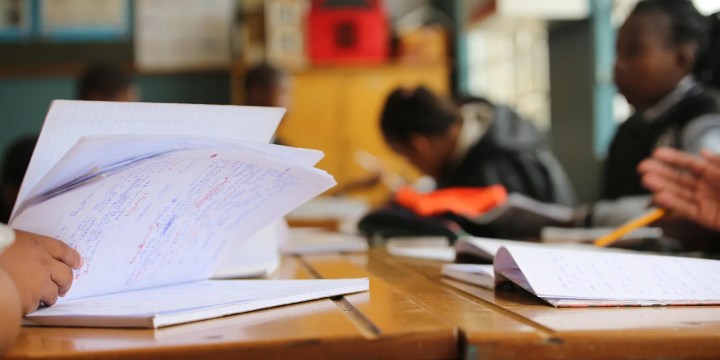NUMBER CRUNCH
Census reveals 5.2m children of school-going age aren’t receiving education

Since 1996, the number of people in South Africa in the 5-24 age group not attending school increased from 5.09m to about 5.4m (26.6%), Census 2022 has revealed.
When President Cyril Ramaphosa addressed the nation after the release of Census 2022 on Tuesday, 10 October, he said the point of the census was to equip South Africa with the information necessary to ensure that no one was left behind.
While great strides have been made in improving access to education since democratic South Africa’s first census in 1996, with school attendance increasing from 70.1% in 1996 to 73.4% in 2022, not much has changed since 2011, when the census before the current one was held.
The good news is that the number of people between the ages of five and 24 at schools in SA increased from 13.8 million to about 14.5 million.
However, since 1996, the number of people in that age group not attending school increased from 5.09 million to about 5.4 million (26.6%). Between 2011 and 2022, more black, Indian and Asian people attended school, while attendance for coloured and white people dipped.
Alarmed by the statistics, the civil society organisation turned political party Build One South Africa (Bosa) released a statement calling for Minister of Basic Education Angie Motshekga to be sacked.
The party said, “Despite President Ramaphosa’s recent claims that the ANC government has increased access to education during its time in office, at least 5.2 million young children of school-going age are not in formal education — an increase of 200,000 in the past decade.”
Bosa said that Motshekga had overseen the gradual decay in the education of South Africa’s young people.
It called for Ramaphosa to fire Motshekga and replace her with a “competent, qualified and committed individual from the education sector”.
Bosa added, “Every South African child should be able to become anything they want to be through education in any school in the country. This will not happen with Angie Motshekga holding the power to decide their futures.”
Elizabeth Biney, head of research at Equal Education (EE), told Daily Maverick that while the census paints a broad picture of access to education based on a sample of the population, it falls short of providing nuances that a more detailed data set such as the current school enrolment statistics would give.
Biney said the data had to be examined in terms of what phase of schooling the individual being counted was in. The census, however, lumps all individuals aged between five and 24 into one data set, making that distinction difficult.
Biney offered some clarity on the matter: “At the primary school level, the sector is doing fantastic. It is on point in achieving near-universal access because we’ve got close to 100% of learners who are supposed to be in school. So we are doing well in terms of access at that level, purely because it is compulsory.”
Biney said that the problem concerning school attendance was at the secondary level, grades 9 to 12.
“That’s where the access story is. It’s a little bit shaky because we’ve got high dropout rates in that area. At this level, schooling is not regulated in that it is not compulsory for [learners] to attend. So at that secondary school level, that’s when a lot of dropouts or force-outs out of the system happen. That’s where you get some of those five million that [the census] is talking about.”
This is evidenced by the census, which shows that while attendance increased to an almost universal level between 1996 and 2022 for children aged five to six, the attendance rate declined for ages 15-24 over the same period.
The latest General Household Survey released in 2021 not only found an increase in dropouts in the secondary education phase, but also reported that learners between the ages of five and 18 didn’t attend school for the following reasons:
- Illness and disability (22.7%);
- Poor academic performance (21.2%);
- Lack of money for fees (19.5%); and
- Family commitments (7.8%).
While the survey pointed to the Covid-19 pandemic and subsequent lockdown as the cause for the majority of dropouts and non-attendance in 2020/2021, Biney said the pandemic could not be singled out as the root cause.
She said the closure of schools during the Covid-19 lockdown and pandemic exacerbated the weaknesses and challenges already in the system.
“While Covid did not necessarily introduce these issues or challenges, it’s made existing challenges worse, which then compounded the probability of learners dropping out of the system or being forced out of the system. So we could argue the increase in dropouts might have been as a result of Covid-19, but that cannot be the sole explanation.”
Keeping learners in school
According to the census, the ultimate goal for SA’s education sector is to keep children in school until they complete their education. Still, the count found that only 37.6% of the population completed matric. While the number of people 20 years and older with no formal education decreased from 19.1% in 1996 to 6.9% in 2022, nearly 2.6 million in the group still have no schooling, while 1.3 million had completed only primary education.
Mpumalanga and Limpopo had the highest percentage of people with no schooling (11.7% and 14.1%, respectively). The lowest percentage of people with no education was in the Western Cape (2.3%), followed by Gauteng (3.9%).
Biney said that the education sector was faced with a problematic situation which required it to find ways to engage with learners and keep them in school beyond the secondary education phase.
“We need to look for creative ways to address some of the systemic issues that actually cause learners to disengage or force them out of the system. We need to put [learners] through the system and ensure smooth progression,” Biney added.
The Department of Basic Education already had certain interventions to offset socioeconomic constraints that contribute to school dropouts and grade repetition.
The School Fee Exemption policy allows for learners from low-income families to be exempted from paying school fees. The National School Nutrition Programme and scholar transport, while in some cases inefficient, provide some social protection, ensuring that a learner’s economic situation does not hinder their access to education.
Biney said the social protections needed to be strengthened.
“Learners need to be monitored from the beginning to the end. While focusing on key strategic places like matric results and matric exams works, [the system] doesn’t look at what is happening in the build-up to that matric level.
“The social issues, the financial issues, economic issues, whatever the systemic issues that are contributing to learners not getting to matric are problematic. So we just need to strengthen the interventions and make sure that they are reaching the learners that are in need and deserve it.” DM




















 Become an Insider
Become an Insider
How do you get to 26% ? 5.09 m plus 26 % = 6.4 m ?
And over half of those in primary school can’t read for meaning – probably why they drop out. Children being pushed into the next grade without the necessary skills is part of the problem. I recall a recent report about primary school teachers not being able to solve arithmetic problems – how did they manage to graduate? Fire Motshekga along with many others then do a skills audit. Our politicians live like kings in a country where kids can’t afford school?